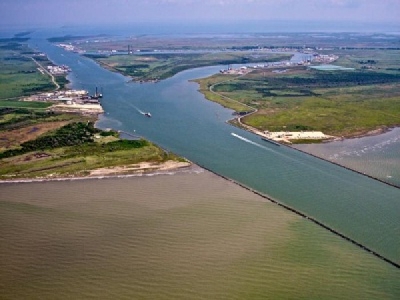
Posted on August 15, 2016
The Calcasieu Ship Channel runs 34 miles from the Gulf of Mexico to the Port of Lake Charles Harbor and Terminal District. The port is the 11th largest seaport in the US and an important economic power in southwestern Louisiana. Lake Charles boasts a thriving refinery industry which relies on keeping the channel clear for ever-larger deepdraft vessels. Annually, 1,000 ships traverse the channel carrying approximately 56.5 million tons of cargo. The Port expects that number to more than double by 2023. That increase will depend upon the channel’s continuing viability for large vessel navigation.
Engineered in the 1920’s, the channel has been widened, straightened, and deepened throughout its history to accommodate modern vessels; the channel is currently authorized for a 40 foot depth and a 400 foot width. According to the port website, as a result of the Calcasieu Ship Channel, the LNG and petrochemical industries will grow substantially by 2023.
The US Army Corps of Engineers and the Port share responsibility for keeping the channel dredged and clear of obstructions. The Corps handles the dredging with federal funds, while the Port must maintain sufficient disposal areas along the channel for the silt and sand brought up by dredging equipment. As reported in May by American Press, this year the Port’s share of the dredging project will cost $3.3 million. In addition to this expense, the Port must also carry the cost for the real estate needed for dump sites, and it must maintain levees to contain the material. This year the State of Louisiana will receive about $118 million in taxes from channel business; the Port will require $8 million of that amount to keep the channel open. In the past, the state has dragged its heels on appropriating funds for the Port’s costs.
An April article in the Journal of Commerce noted that more than $80 billion in energy-related development is planned or has begun in this corner of Louisiana. Energy and petrochemical firms are attracted to Lake Charles due to its location near major natural gas pipelines and the port facilities which include 12 deep-water berths and 1.6 million square feet of storage. Despite the recent soft energy prices, companies such as G2X Energy, Magnolia LNG, and Lake Charles Clean Energy have already leased space in its facilities. Sasol is constructing an $8.9 billion ethylene plant (expected to open in 2019). Citgo, Cameron LNG/Sempra Energy, Trunkline LNG, and Juniper GTL are beginning the permitting process for other construction projects.
Source: PortVision





